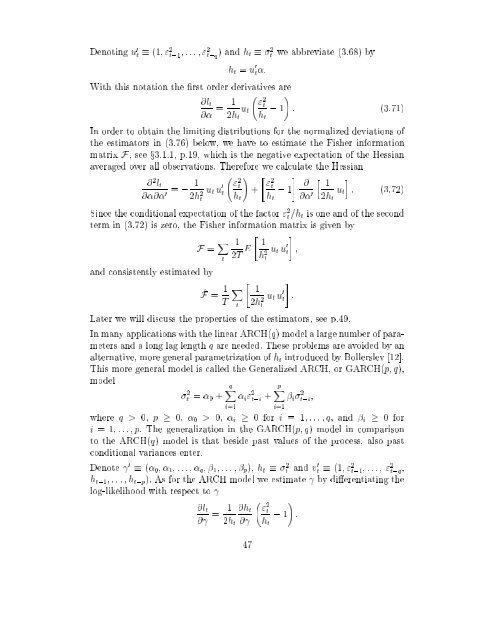Estimation in Financial Models - RiskLab
Estimation in Financial Models - RiskLab
Estimation in Financial Models - RiskLab
Create successful ePaper yourself
Turn your PDF publications into a flip-book with our unique Google optimized e-Paper software.
Denot<strong>in</strong>g u 0 t (1;" 2 t,1;:::;" 2 t,q) and h t t<br />
2 we abbreviate (3.68) by<br />
h t = u 0 t:<br />
With this notation the rst order derivatives are<br />
@l t<br />
@ = 1 u t<br />
2h t<br />
" 2 t<br />
h t<br />
, 1<br />
!<br />
: (3.71)<br />
In order to obta<strong>in</strong> the limit<strong>in</strong>g distributions for the normalized deviations of<br />
the estimators <strong>in</strong> (3.76) below, we have to estimate the Fisher <strong>in</strong>formation<br />
matrix F, see x3.1.1, p.19, which is the negative expectation of the Hessian<br />
averaged over all observations. Therefore we calculate the Hessian<br />
@ 2 l t<br />
@@ 0 = , 1<br />
2h 2 t<br />
u t u 0 t<br />
! "<br />
" 2 t "<br />
2<br />
+ t<br />
, 1<br />
h t h t<br />
# @<br />
@ 0 1<br />
2h t<br />
u t<br />
<br />
: (3.72)<br />
S<strong>in</strong>ce the conditional expectation of the factor " 2 t =h t is one and of the second<br />
term <strong>in</strong> (3.72) is zero, the Fisher <strong>in</strong>formation matrix is given by<br />
F = X t<br />
and consistently estimated by<br />
^F = 1 T<br />
1<br />
2T E " 1<br />
h 2 t<br />
X<br />
t<br />
" 1<br />
2h 2 t<br />
u t u 0 t<br />
u t u 0 t<br />
Later we will discuss the properties of the estimators, see p.49.<br />
In many applications with the l<strong>in</strong>ear ARCH(q) model a large number of parameters<br />
and a long lag length q are needed. These problems are avoided by an<br />
alternative, more general parametrization of h t <strong>in</strong>troduced by Bollerslev [12].<br />
This more general model is called the Generalized ARCH, or GARCH(p; q),<br />
model<br />
2 t = 0 +<br />
qX<br />
i=1<br />
i " 2 t,i +<br />
pX<br />
i=1<br />
#<br />
#<br />
:<br />
;<br />
i 2 t,i;<br />
where q > 0, p 0, 0 > 0, i 0 for i = 1;:::;q, and i 0 for<br />
i = 1;:::;p. The generalization <strong>in</strong> the GARCH(p; q) model <strong>in</strong> comparison<br />
to the ARCH(q) model is that beside past values of the process, also past<br />
conditional variances enter.<br />
Denote 0 ( 0 ; 1 ;:::; q ; 1 ;:::; p ), h t t<br />
2 and vt 0 (1;" 2 t,1;:::; " 2 t,q;<br />
h t,1 ;:::;h t,p ). As for the ARCH model we estimate by dierentiat<strong>in</strong>g the<br />
log-likelihood with respect to <br />
@l t<br />
@ = 1 !<br />
@h t " 2 t<br />
, 1 :<br />
2h t @ h t<br />
47
















